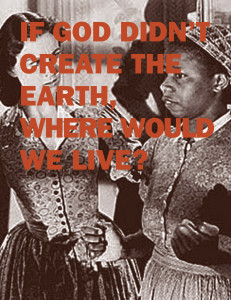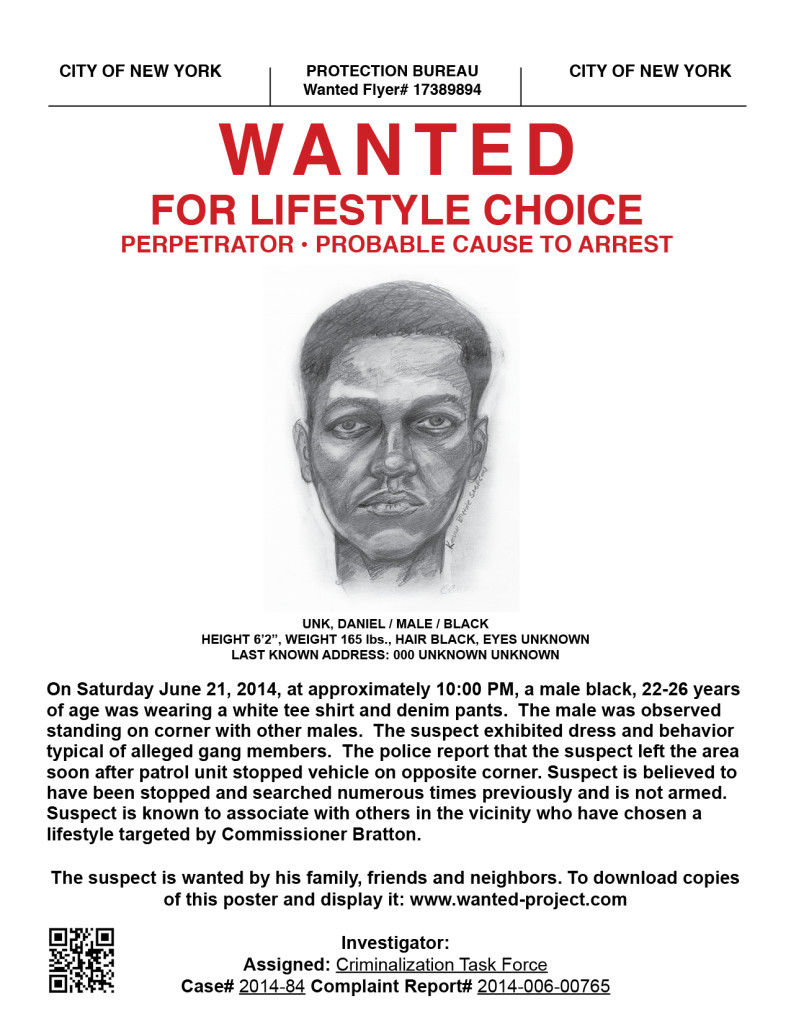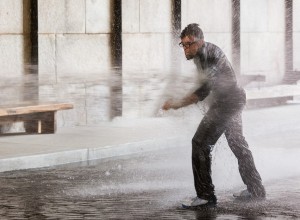
I know Dread Scott for almost 25 years. He was participating in my travelling exhibtion Postrcards from Black America (1998-1999). He is one of these rare artists who makes political art that influences the public opinion. He has not only a clear message but he also knows how to use visual means to convey his message.
This interview was first published in January 2015. It is still relevant, so I like to publish it again.
On the impossibility of freedom in a country founded on slavery and genocide, performance, 2014.
GIVING UP IS NOT AN OPTION
An interview with Dread Scott
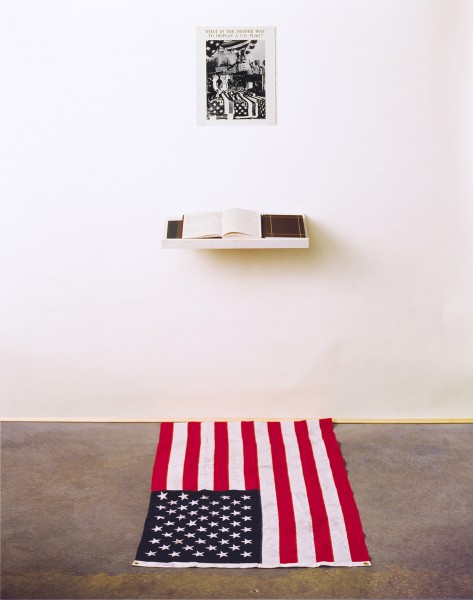 What is the proper way to display a US flag, installation 1988.
What is the proper way to display a US flag, installation 1988.
The first time I met Dread Scott was in 1995. I was preparing the exhibition and the book ‘Postcards from Black America’. Although he was still a young artist, he was already known for a controversial work he made in 1989 – ‘What is the Proper Way to Display a U.S Flag? – in which he ‘used’ that flag. Bush called it ‘disgraceful’. Members of the Senate were furious.
Over the years we stayed in touch with each other. I saw several shows with his work in it, I read about his public performances in the newspaper.
Since I was wondering what it means to fight injustice through art for over 25 years, being controversial in the eyes of many people, not selling much because of that, I decided to interview him.
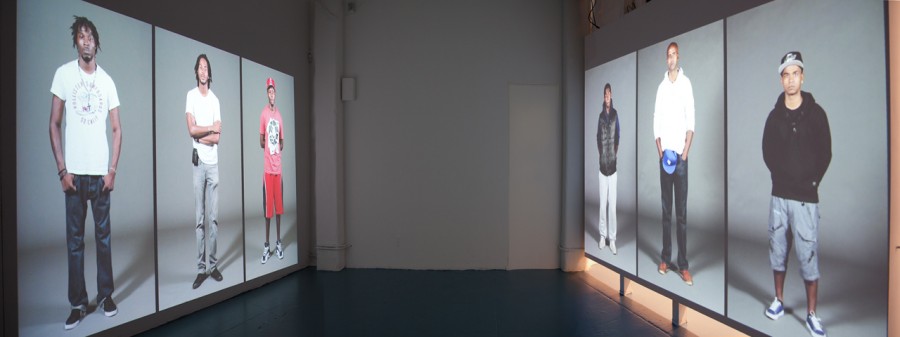 Stop, 2 channel projected HD video installation, 2012.
Stop, 2 channel projected HD video installation, 2012.
Rob: How do you call the kind of art you make: Political? Revolutionary? Activist?
Dread: I make revolutionary art. Calling art political or activist doesn’t describe the politics of the work. Leni Riefenstahl and D. W. Griffith each made political films, but my work is radically different than theirs. I think that artists and critics should not be content with saying that artists work is political. What are the politics?
Rob: When did you know what kind of art you wanted to make? Before you went to art school?
Dread: In art school I was a young student trying to figure out many things about life, like most young people. I was looking at a range of politics, philosophies etc. and trying to understand the world, that as a young adult, I was finely allowed to have some say in. In the course of this I became a communist and as a young activist began to think about what kind of art corresponded to the new understanding I had of the world. It was through a process of intellectual inquiry, which all schools should challenge you to undergo that I arrived at the kind of work I have been doing since the mid 1980s.
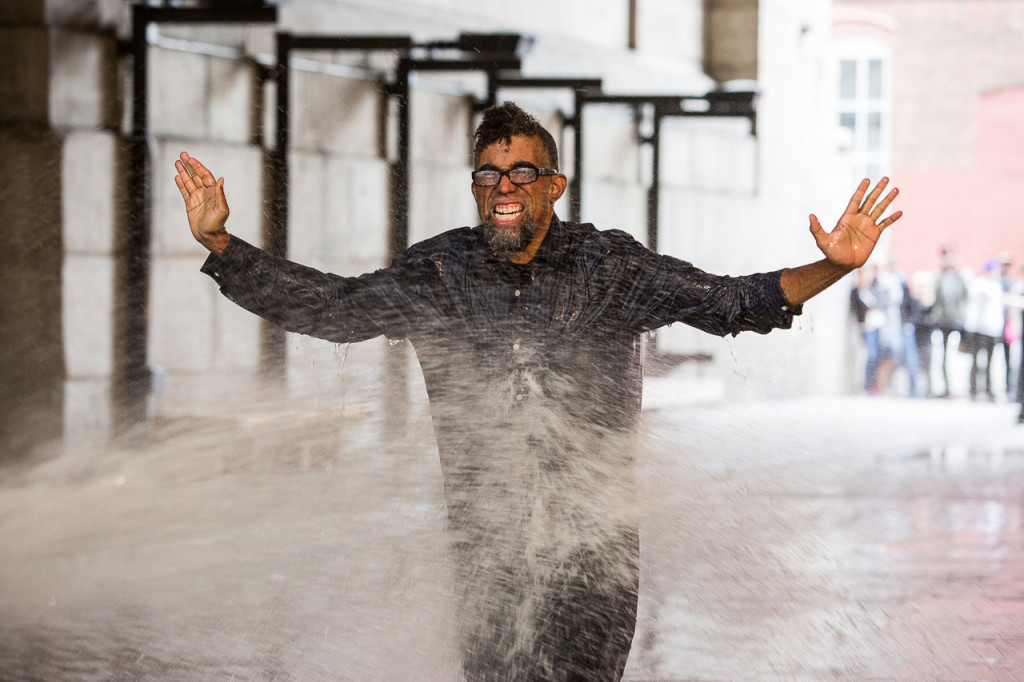 On the impossibility of freedom in a country founded on slavery and genocide, performance, 2014.
On the impossibility of freedom in a country founded on slavery and genocide, performance, 2014.
Rob: Has your family background to do with your choice?
Dread: If by family you mean, parents, grandparents etc, I think that it shaped me in the sense that as the first sizeable middle class generation of Black people, my parents’ generation valued education and sent me to an elite private school for primary school and high school (age 6-18). I was engaged in critical thinking form an early age and this was in part because they saw this a way to overcome the systemic racism that defines America. And this has had a significant effect on my thinking and thus my art. If by family background you mean, growing up Black in America, this too has influenced my worldview tremendously. Not all Black people in the US come to the same understanding I have of the world, and you don’t have to be Black to come to this outlook, but it has deeply influenced my experience and thus my art.
Rob: You took the (art)world by storm in 1989 with your installation ‘What is the proper way……”. Did you expect the furious reactions? How did you deal with it? Did it make you doubt about your decision to make art like that or was it more the other way around: A confirmation that you made the right choice?
Dread: I had no idea that the response to the work would be what it was. But the response re-affirmed and deepened my view that this was the kind of work that was urgently needed in the world.
Rob: When you decided to make art with a political message you must have thought about a strategy how to present your messages? Can you tell a bit more about that process? (I ask this because it looks as if the media you use are unlimited and, on the other hand, some of them – like the poster – are classical from a left wing revolutionary point of view…..as if Castro was on your shoulder…..).
Dread: Most of my art starts from ideas. I think about an important social question that I think needs to be engaged. And in thinking about this try to find the best way that I can to address this. I have a strong background in photography and many projects use photography. But I don’t feel limited to any medium. If the idea would be best represented by video, performance, painting…, I try to develop enough skill in a particular media to execute the projects. The key thing is connecting the ideas to an audience. What needs to be said to a particular audience and how can the work convey those ideas? I also seek to have my work resonate with a diverse audience. People with art backgrounds may see different things in my work than people without that training, but I think that contemporary art can resonate deeply with people of all backgrounds if I do my work well.
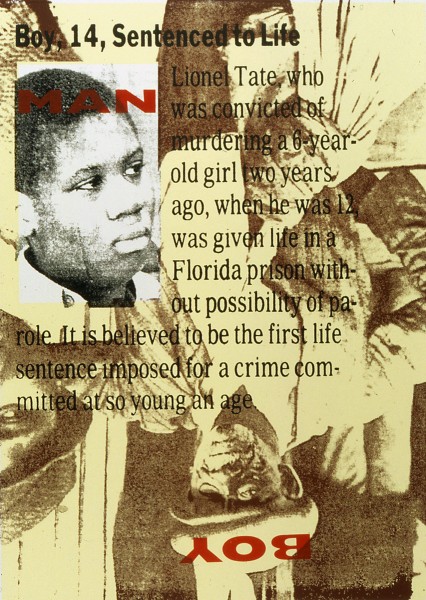 Boy Man, 2002.
Boy Man, 2002.
Rob: I guess another decision you had to make was: where do I show my art? In the public space for a ‘normal’ audience or in a museum for an elite audience. You do it both but that is perhaps a compromise kind of decision………Your CV shows many respected institutions………don’t they neutralize your message just by being an official institution?
Dread: I tell people I show everywhere form major museums to street corners, with or without permission. I think that it is important to reach a broad general public as well as a mainstream art audience. I tremendously value the work I do in public on the streets reaching an un-expecting audience but I don’t feel it is a compromise to show in museums or commercial galleries. I don’t “dumb down” or soften the work I make that is shown in these institutions. I know of the work of Leon Golub, Ai Weiwei, Roy Decarava, Tania Bruguera etc, because they showed in mainstream institutions. And I’m thrilled when my work is in major museums, in part because I know that all sorts of people, including kids on field trips and tourists wondering what Black people think of America will see the work. I like the reach that mainstream museums have and I’m glad when my work enters more of the heart of the art world dialogue, because it is in the spaces that generate this dialogue. I hope that through my work being in institutions like this, the kind of work that I do and the questions that my work addresses become much more common in the mainstream art world. In short, while they may be trying to neutralize my message, I’m seeking to radicalize theirs.
Rob: Within this context: writing and talking (interviews, radio, tv) are also part of the package. Not really what you expect from an artist. Why are these media also important for you? Do they, at the end, work better?
Dread: I’m trying to change the world and if radio, TV, newspapers etc can reach a broader audience and/or help them engage the ideas in my work then I’m happy to do interviews. The national section of the newspaper reaches more people than art review in the art section.
Rob: You will hear the remark a lot: art cannot change the world. How do you react on this kind of remarks? Is your belief as strong as it was when you started your career?
Dread: The world is a horror and cries out for revolution. The world is always changing and it is people that change the world. In some periods it can change dramatically – in ways that are in the interest of humanity and in reactionary ways as well. There have been revolutions in the past and there will be in the future. I want my work to contribute to a broader movement for revolution and be part of a discourse about the cohering norms and values of this society and about how the world can be radically different and far better. While many people say art can’t change the world, I think that people who say that have accommodated themselves to living in this horrible world and have given up on changing it. What they say is not true and should be ignored.
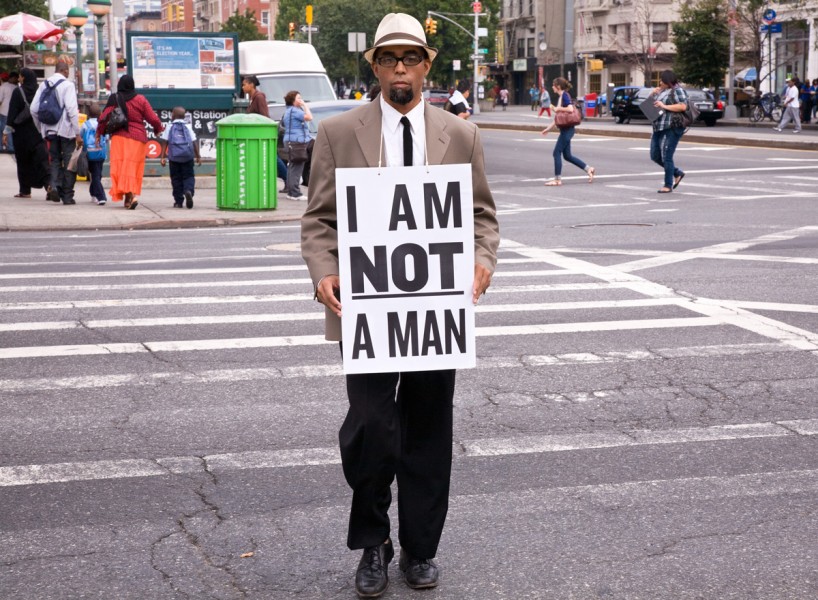 I am not a man, performance in Harlem, 2009.
I am not a man, performance in Harlem, 2009.
Rob: Can you mention the projects that are the most effective in your eyes?
Dread: I think Ai Weiwei’s work about children killed in the 2008 earthquake is very important. He has done a few projects on this and I like them all. I think Wafaa Bilal’s “Domestic Tension” (aka Shoot an Iraqi) was really great in challenging people to confront what the US was doing to the people of the world and for American’s to confront their responsibility within that. I think that Rodchenko’s work and many of the Soviet Avant Garde works are effective and we can learn a lot from them, especially about art in a revolutionary society. As for my works, I think that “Dread Scott: Decision” is one of my most significant and effective works. It looks at a country that’s democracy is founded on slavery, the connection between slavery and the conditions Black people have faced and continue to face in America and the ethical responsibility of people in change these conditions and the means by which to do that.
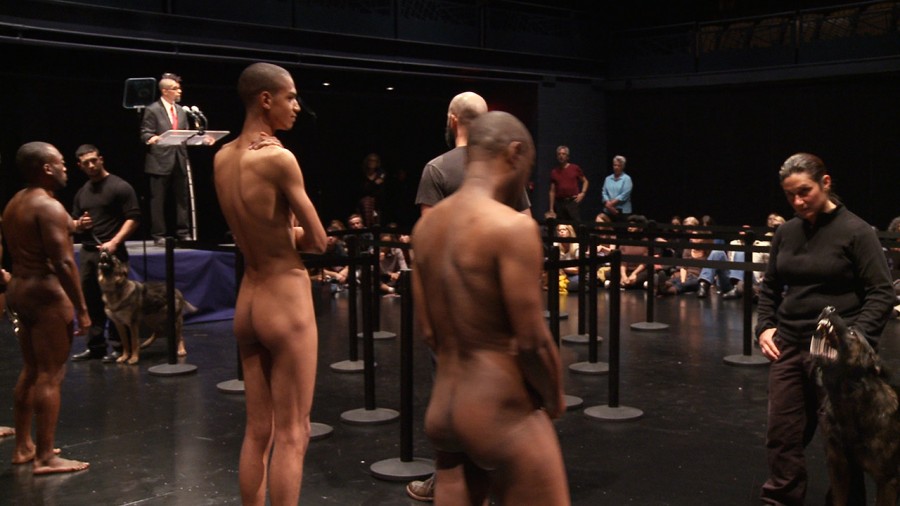 Decision, performance about the Constitution, 2012.
Decision, performance about the Constitution, 2012.
Rob: Are you disappointed about the reaction of art critics on your work?
Dread: My work would have more impact and influence on society if a broader section of art critics engaged my work in a more substantial way. My work is not unknown and in fact is taught in many introductory art history classes, but I would like there to be a more developed writing about it. That said, the commercial art world has an outsized influence on the discourse in the arts today. My work is mostly not part of the commercial art market and so even writers who may value my work, would have trouble writing about it as I don’t show in spaces that they are commissioned to write about.
Rob: Is there one leading theme in your work or do circumstances or news facts determine the theme?
Dread: Facts determine my theme. But in broad brush strokes, my work has encouraged people to re-examine cohering norms of US society.
Rob: In many projects you involve other people (kids, students etc.). What is the philosophy behind it?
Dread: The people I collaborate with often very directly experience the brutality and exploitation that is foundational to America. It is young Black kids who get harassed by the police, prisoners, young people who have no future under this system. Their experience, understanding, lives, and images are often excluded from mainstream dialogue, including in art. I both learn a lot from the people I work with and think that drawing on their experience can make art that can help people understand a lot about this society. For example many people are opposed to racial profiling and constant harassment of youth that is concentrated in “Stop and Frisk” policing. But many middle class people don’t know have to confront youth who are stopped 50, 75 or 200 times by the police, all while doing absolutely nothing wrong. Putting faces to this and enables people to understand this on a much more visceral level.
Rob: Was there ever a moment that you thought: Fuck you all. I gave up. I am going to make elegant, seductive paintings that sell well.
Dread: I’d be lying if I didn’t say that sometimes living in this world is discouraging. And for an hour here or a day there I might feel like giving up. But the short answer is “no.” I have a deep understanding that the world doesn’t have to be the way that it is and I have a lot to contribute to making it radically different. Giving up is not an option.
Rob: The situation for blacks in the US now – with all the Ferguson kind of incidents – seems unchanged. How do you look at this situation? Did you fail as an artist? With f.i. your ‘Wanted’ project you more or less predicted what is happening now, but you did not have an influence on it?
Dread: The police killing of Michael Brown is the norm. What is profoundly changed is that in response to that people all over the country are resisting. They are fighting back. ‘Wanted’ spoke to how the police criminalize the youth and was a way for people to challenge this. My work, though not responsible for people fighting back, is part of the mix. Far from failing, I am dancing in the streets now and straining to have the work resonate and connect even more.
Wanted, project on criminalization of youth in America, 2014.
Rob: Are you disappointed by the reaction of Obama on the heated-up-situation? Mayor De Blasio was more direct…….
Dread: Obama is the head of an imperialist empire. I had no expectations that he was in the interest of the people so I was not disappointed by his pleas for people to be calm and let the system work. I’m happy that people ignored his poisonous advice. De Blasio is the head of a major American metropolis and is responsible for the terror and brutality that the NY Police Department targets the people with. He brought in the police chief who is largely responsible for stop and frisk and for the policies that lead directly to the murder of Eric Garner. This is a country that has police who murder its citizens, have the murders caught on video and failed to indict the murderer. This system is illegitimate and any elected official who cannot plainly state that the police who committed the murders should be indicted, convicted and jailed for their crimes is both morally bankrupt and illegitimate.
Rob: Are you happy about the changed relation between the US and Cuba?
Dread: I’m happy that the people of Cuba will no longer face hardship imposed by the US embargo (if it is actually lifted). But I think that the people of Cuba, like the people in the US, need revolution. But that is a longer discussion.
Rob: In your CV I read that one of your projects was shown in Harare. Do you spread your wings or was it an accident?
Dread: I’m glad about the show in Harare. It was a bit of an accident, but I’m always eager to exhibit outside of the US. I very much want my work to reach beyond the borders of the US and believe that people internationally are interested in what a Black revolutionary form America has to say. And I am very happy when I have the opportunity to be part of a broader international dialogue.

